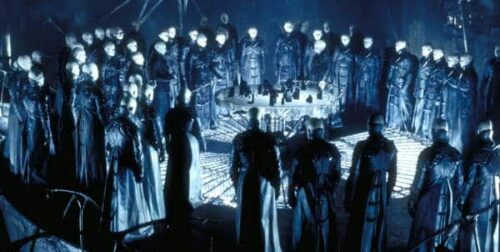Consider a world in which The Matrix, the legendary science-fiction film, takes a darker, more enigmatic turn, embracing noir themes and introducing creepy aesthetics that engulf you in an unpleasant tale. Consider The Matrix’s iconic agents transformed into monstrous entities akin to Hellraiser’s Pinhead. You may compare the end effect to Dark City, a thought-provoking and overlooked film from 1998. However, don’t confuse Dark City for a mere imitation; rather, consider it a predecessor because it debuted a year before The Matrix. In this article, we delve into Dark City’s cinematic brilliance and examine how it revolutionised and defied the psychological science fiction subgenre.
Dark City Defined: George Orwell Meets the Noir Matrix
Dark City: An Unidentified Realm
Dark City transports us to a city wrapped in mystery, devoid of time or location. Our main character, John Murdock, awakens in a strange hotel room next to a lifeless woman, stripped of his past and memories. However, it quickly becomes clear that this is not your ordinary crime thriller or rendition of American Psycho.
As John investigates his situation and strives to avoid the unrelenting cops, he discovers a mind-boggling truth about the city itself. It’s not a genuine metropolis; rather, it’s a perfectly crafted facade hovering in space, resembling a cosmic laboratory devoid of realism. The residents, including John, have distorted memories that have been painstakingly constructed by a parasitic alien culture with nefarious intents. These extraterrestrial beings, who live within recently departed human bodies, have a Hellraiser-like look, with pallid, hairless faces. Water and light, strangely, are lethal to them, explaining the city’s continuous darkness and lack of natural bodies of water.
Unbeknownst to the residents, they are unintentionally participating in a massive telepathic experiment sponsored by these extraterrestrial entities. Every night, their memories are switched in order to learn how various personalities react in different situations.
Dark City| A Brief Explanation of the Ending
While the aliens strove to unravel the mysteries of human nature, John, by sheer perseverance, masters their telepathic powers, known as “tuning.” He uses his newfound abilities to challenge and eventually overthrow the alien race.
The Matrix| Did Dark City Influence It?
It’s difficult to deny Dark City’s influence on The Matrix, given that the former was made before similar-themed films like eXistenZ and The Thirteenth Floor. Dark City provides a narrative counterpart, introducing us into an analogue environment rather than the digital sphere of The Matrix. Dark City delves into sophisticated clockwork mechanics, producing a distinct steampunk style, whereas The Matrix depends on intricate digital codes to discover humans.
Dr. Daniel Schreber from Dark City, in particular, shows a remarkable similarity to Morpheus from The Matrix. Schreber’s call sends John on a transformative trip that mirrors the upload of martial arts information to Neo’s consciousness in The Matrix. Furthermore, Mr. Hand, an alien with access to John’s memories, resembles Agent Smith, a dangerous foe who gains autonomy following a shared experience with the protagonist.
Dark City asks audiences to consider the limits of reality and the great power of one’s thoughts, making it a forerunner to The Matrix, despite their unique execution techniques.
Orwellian Approach to Memory Concept
The influence of George Orwell is evident in Dark City, notably in its portrayal of memory. The video transports us to a future where authorities use syringes and hypnosis to modify memories, mimicking the manipulation of historical fact in Orwell’s literary works, 1984 and Animal Farm. The upshot is the same in both Dark City and Orwell’s dystopian works: the erasure of the “prior version of the truth.”
The film Dark City emphasises the underlying philosophical nature of truth as well as the intrinsic fallibility of human memory. People frequently misinterpret experiences and recollections, making it difficult to recall an event exactly as it occurred. As the extraterrestrial race grows inexplicably fascinated with human individuality, potentially suppressing it within their hive-like conscience, the film mimics Orwell’s investigation of the possibility for malignant powers to exploit these cognitive frailties.
New Directions in Science Fiction
Dark City stands out in the world of science fiction thanks to its novel narrative tactics. The film deftly blends a current environment with steampunk technology, in which telepathy exists but must be amplified through elaborate clockwork equipment. This contrast gives a new layer to the film’s setting, prompting spectators to ponder the limits of science fiction.
Furthermore, Dark City skillfully implements the “show, do not tell” strategy, with determined antagonists and complicated, flawed heroes. Dark City argues that these alien creatures are motivated by a desperate need for survival, developing a distinct sense of purpose, in a refreshing change from usual sci-fi cliches in which an extraterrestrial species is typically portrayed as the instigator of experimentation.
The video poses provocative philosophical problems, challenging the order of impact between personality and the external world, a topic that has piqued the interest of philosophers for millennia. The aliens’ hunt for answers parallels humanity’s age-old desire for comprehension, giving Dark City a rich tapestry of concepts.
Dark City| Closing Reflections
To summarise, Dark City is a great and undervalued picture of its period, distinguished by its innovative ideas and concepts. While The Matrix did not literally mimic Dark City, it did draw inspiration from it. Both films were shot in Australia, which provides a credible explanation for their shared settings. If you haven’t yet experienced Dark City’s cinematic journey, it’s a captivating experience worth your time. Dark City, in the end, is a thought-provoking cinematic masterwork that stays intriguing and relevant even years after its initial release.
ALSO READ THIS: Explaining God’s Crooked Lines|Conclusion:Was Alice Crazy?
